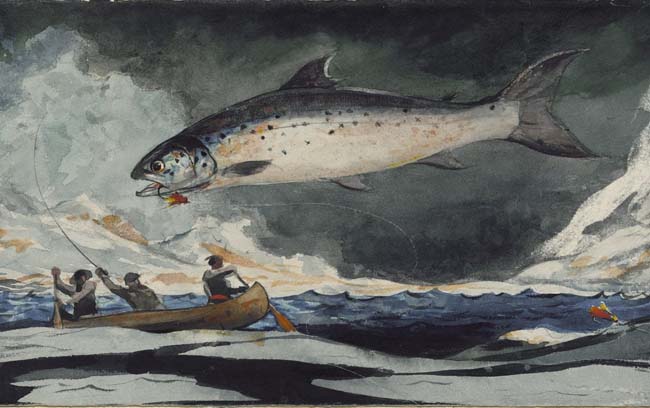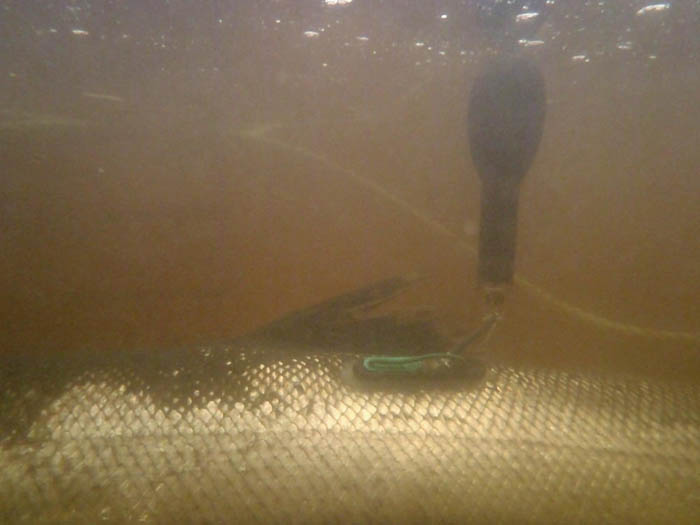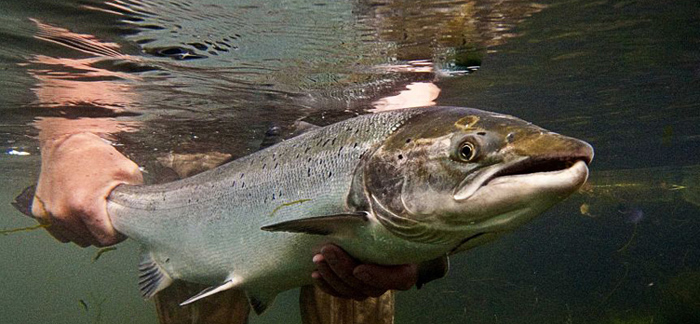
Winslow Homer, “A good pool, Saguenay River,” Sterling and Francine Clark Art Institute, Williamstown, Massachusetts. A commons image.
By Colin Chisolm and Sara Ericcson / Saltwire Network / September 6, 2018
[dropcap]T[/dropcap]om Smith says it’s “misleading” that Atlantic Canadian aquaculture farmers are being blamed for European farm salmon spawning in the Bay of Fundy over the past two decades.
Fisheries and Oceans Canada published a report Aug. 31 confirming the presence of European farm salmon in the inner Bay of Fundy, and says the fish’s spawning has created a hybrid species in the Bay of Fundy.
The Atlantic Salmon Federation released a report Sept. 6 and says it’s “disturbing” that DFO research has found the fish have been spawning in the bay’s inner waters since 1997, and that it identifies Atlantic open net-pen salmon aquaculture as the “likely source.”
It is this finger-pointing that Smith, the executive director of the Aquaculture Association of Nova Scotia, disputes. He says Atlantic aquaculture farms use a strain called Saint John River salmon, and that while he cannot confirm this strain is absolutely without genetic impact from the European strain, the fish has the ocean department’s stamp of approval.
This is why he says he’s “concerned” DFO has named Atlantic farmers as the likely source.
It’s impossible to say it’s 100 per cent not related to the European strain, but we’ve been farming this approved fish for years and years. So yes, I dispute this, because we are not the source,” he says.

Satellite Tag and Harness, a tool of ASF’s Research program in 2012. After five months the tag will pop off, and transmit data of path and depth to a satellite. (photo ASF Research)
Where did European salmon come from?
Neville Crabbe, director of communications with the Atlantic Salmon Federation, confirmed Saint John River salmon are the only permitted strain in the Maritime industry.
He also confirmed through the report that the European strain of fish is desirable for commercial reasons, but has never been legally permitted for introduction into New Brunswick or Nova Scotia waters.
Crabbe says the report presents evidence of “recent and sustained use” of European origin salmon by the aquaculture industry, highlights the need for government to intervene and shows the aquaculture industry is in violation of multiple aquaculture and protection acts. “[The industry] is in violation of New Brunswick’s Aquaculture Act and the Federal Species at Risk Act and …Canada’s international obligations under the Williamsburg Resolution…, which prevents the introduction of non-native salmon in domestic waters,” he says.
The species impacted by this spawning is the Inner Bay of Fundy population of Atlantic salmon –an endangered species formally protected by Canada’s Species At Risk Act.

Ron Sutliff Atlantic Salmon Federation.
Losing adaptions
Darren Porter, a fisherman in the Bay of Fundy and past aquaculture farmer, says he’s not surprised the protection of this wild population is a “low priority” for the Nova Scotia government, which has jurisdiction over the province’s aquaculture industry.
He says the province “doesn’t care” about the inner bay’s wild population because it can profit much more from its farmed populations, and argues the spawning happened because the province’s focus has been with profits, rather than protection.
“Our government wants aquaculture, at any cost. The reason is because it can’t invest much capital in a wild fishery,” he says.
Crabbe says while the source has yet to be fully confirmed, one thing remains certain – the continued presence of foreign, escaped fish continues to threaten to Inner Bay of Fundy Salmon population.
He says he hopes “industry will cooperate with regulators and make the information available” so a firm cause of this spawning can be confirmed, and also wonders what the point of protection measures such as the Species at Risk Act really is if it cannot be used to prevent such spawning and hybrid species of fish.
“When you’re crossing those domesticated fish with wild fish, in just a single generation you’re beginning to lose the adaptations that are absolutely essential for survival in the wild.”
“It’s incumbent upon DFO… Any salmon recovery projects simply won’t be successful so long as there are aquaculture fish swimming around.”

